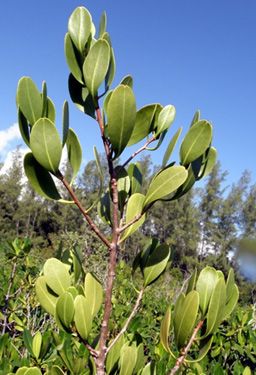This publication provides an in-depth profile of Lumnitzera racemosa for the use of interested laypersons with some knowledge of biology as well as the academic audiences.
Warning: The UF/IFAS Assessment of Non-Native Plants in Florida’s Natural Areas has designated Lumnitzera racemosa as a high-invasion-risk species. Additionally, it is a category 1 invasive species in Florida.
Family
The Combretaceae family is also known as the white mangrove family or Indian almond family (Godfrey and Wooten 1981; USDA n.d.).
Genus
The genus, Lumnitzera, was assigned by Carl Ludwig Willdenow, who named it after the German botanist Stephan Lumnitzer (1750–1806) (Loudon 1830).
Specific Epithet
The species name, racemosa, comes from the Latin root racemus, or "a cluster," in reference to the growth pattern of the inflorescence (flower).
Common Name
Black mangrove or white-flowered black mangrove
Lumnitzera racemosa is commonly called black mangrove and sometimes called white-flowered black mangrove. Be aware, Avicennia germinans, which is native to Florida is also referred to as black mangrove.
Description
Lumnitzera racemosa is native to the Indo-West Pacific, which includes East to Southeast Africa, South to Southeast Asia, and northern parts of Australia (Figure 1). In its native range, the white-flowered black mangrove grows in the higher parts of the intertidal zone along creek banks, rocky beaches, sandy beaches, and mangrove forests. In the United States, Lumnitzera racemosa was first introduced in south Florida during the 1960s and since considered to have the potential for fast population growth. Currently the invasive white-flowered black mangrove occupies a small area in south Florida (Figure 2). According to the UF IFAS Assessment of Non-Native Plants in Florida’s Natural Areas, Lumnitzera racemosa has been designated as a high invasion risk species.

Credit: https://commons.wikimedia.org/wiki/File:Lumnitzera_range_map.png

Credit: EDDMapS 2022
The invasive black mangrove is an evergreen tree or shrub with heights up to 33 feet. Leaves are succulent, simple, and alternate in arrangement (Figure 3). Leaf size ranges from 1–4 inches long and up to 1.5 in wide. Leaves maintain an obovate shape with an indent at the tip (emarginate) (Figure 4), and a wavy leaf margin. The bark of the Lumnitzera racemosa is rough and reddish-brown. The younger branches are more reddish or grey with an appressed pubescence at times. The invasive black mangrove does not have aboveground roots; however, it is unique in its ability to produce adventitious roots in moist environments. Flowers are small, sessile, and white (Figure 5). The fruit are small (<1 in) and yellowish green, with either a glossy, glabrous, or pubescent appearance.

Credit: Jennifer Possley (Wunderlin et al 2024)

Credit: Dennis Giardina

Credit: Dennis Giardina
Characteristics for Identification
There are a few key features to look for when differentiating Lumnitzera racemosa from native Florida mangroves. Use the lists of characteristics below to distinguish between non-native black mangrove and native Florida mangrove species.
Non-native Mangrove
Lumnitzera racemosa (black mangrove)
- Alternate leaf arrangement
- Emarginate leaf apex (indent at tip)
- Wavy leaf margin
- No aerial roots
- No vivipary
- Exists in higher parts of intertidal zone
Native Mangroves
Avicennia germinans (native black mangrove)
- Opposite leaf arrangement
- Acute to obtuse leaf apex
- Entire leaf margin (smooth)
- Pneumatophores (aerial roots)
- Vivipary
- Exists on mid-range of intertidal zone
Laguncularia racemosa (native white mangrove)
- Opposite leaf arrangement
- Entire leaf margin (smooth)
- Vivipary
Potential Treatment
Hand removal is very effective for seedlings and saplings. Hand removal has been the primary tool in the eradication efforts conducted in and around Fairchild Tropical Botanic Gardens. All stems and any fruits should be removed from the site to prevent resprouting or new infestations from seed. While herbicide treatments are also highly effective, the potential to injure surrounding native mangroves may be high. However, for individuals too large to hand pull, a cut stump treatment of a glyphosate product labeled for use in aquatic settings can be applied at 50% v/v. Triclopyr amine is also effective but may increase the potential for non-target damage to surrounding mangroves. There are no bio-controls approved in the United States for this species.
Applications
Commercial/Practical
Historically in its native range, the bark has been used for its source of tannins to treat leather and heavy fabrics.
Wildlife
Currently there are no documented significant wildlife interactions in Florida with this plant.
Horticultural
In Florida, Lumnitzera racemosa classified as a category I invasive species by the Florida Invasive Species Council. Lumnitzera racemosa was initially introduced in Florida at the Fairchild Tropical Botanic Gardens in 1966 for horticultural reasons before it was recognized as a category 1 invasive (Fourqurean et al. 2010).
Special thanks to collaborators from the Fairchild Tropical Botanic Garden South Florida Conservation Program Manager Jennifer Possley and Fish and Wildlife Conservation Commision-Everglades Region Biologist Dennis Giardina.
References
EDDMapS. 2022. Early Detection & Distribution Mapping System. The University of Georgia—Center for Invasive Species and Ecosystem Health. Available online at http://www.eddmaps.org/. Last accessed May 13, 2022.
Fourqurean, J. W., T. J. Smith, J. Possley, T. M. Collins, D. Lee, and S. Namoff. 2010. “Are mangroves in the tropical Atlantic ripe for invasion? Exotic mangrove trees in the forests of South Florida.” Biological Invasions 12 (8): 2509–2522. https://doi.org/10.1007/s10530-009-9660-8
Godfrey, R. K., and J. W. Wooten. 1981. Aquatic and Wetland Plants of Southeastern United States: Dicotyledons. University of Georgia Press.
Loudon, J. C. 1839. Loudon's Hortus Britannicus: A Catalogue of All Plants, Indigenous, Cultivated In, or Introduced to Britain. London: Printed for Longman, Orme, Brown, Green, and Longman. https://doi.org/10.5962/bhl.title.68944
USDA. (n.d.). Lumnitzera racemosa Willd. white-flowered black mangrove. USDA plants database. Retrieved May 27, 2022, from https://plants.usda.gov/home/plantProfile?symbol=LURA3
Wunderlin, R. P., B. F. Hansen, A. R. Franck, and F. B. Essig. 2024. Atlas of Florida Plants. [S. M. Landry and K. N. Campbell (application development), USF Water Institute.] Institute for Systematic Botany, University of South Florida Tampa. https://florida.plantatlas.usf.edu/